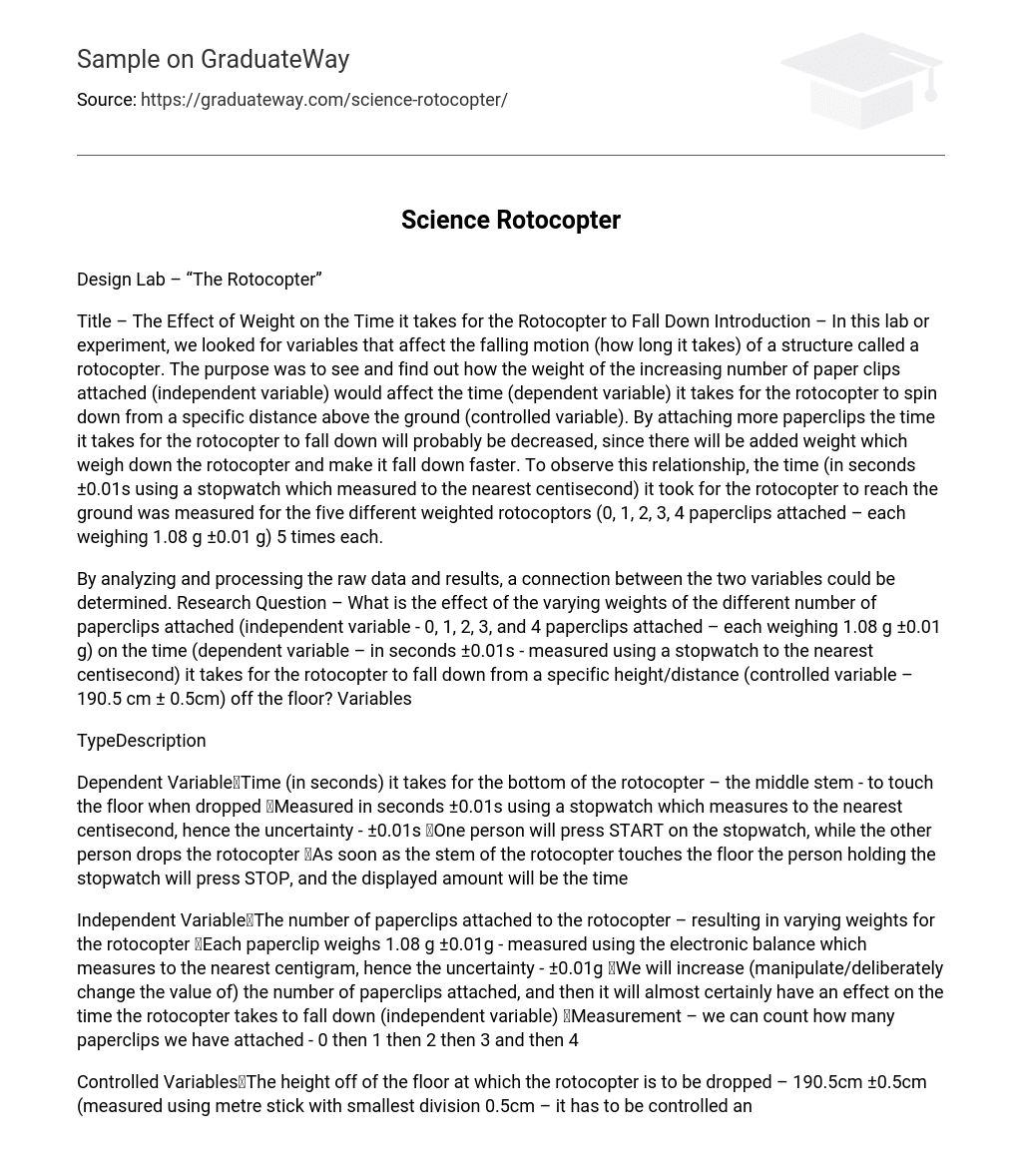In this lab or experiment, we looked for variables that affect the falling motion (how long it takes) of a structure called a rotocopter. The purpose was to see and find out how the weight of the increasing number of paper clips attached (independent variable) would affect the time (dependent variable) it takes for the rotocopter to spin down from a specific distance above the ground (controlled variable).
By attaching more paperclips the time it takes for the rotocopter to fall down will probably be decreased, since there will be added weight which weigh down the rotocopter and make it fall down faster. To observe this relationship, the time (in seconds ±0.01s using a stopwatch which measured to the nearest centisecond) it took for the rotocopter to reach the ground was measured for the five different weighted rotocoptors (0, 1, 2, 3, 4 paperclips attached – each weighing 1.08 g ±0.01 g) 5 times each.
By analyzing and processing the raw data and results, a connection between the two variables could be determined. Research Question – What is the effect of the varying weights of the different number of paperclips attached (independent variable – 0, 1, 2, 3, and 4 paperclips attached – each weighing 1.08 g ±0.01 g) on the time (dependent variable – in seconds ±0.01s – measured using a stopwatch to the nearest centisecond) it takes for the rotocopter to fall down from a specific height/distance (controlled variable – 190.5 cm ± 0.5cm) off the floor?
Dependent Variable Time (in seconds) it takes for the bottom of the rotocopter – the middle stem – to touch the floor when dropped Measured in seconds ±0.01s using a stopwatch which measures to the nearest centisecond, hence the uncertainty – ±0.01s. One person will press START on the stopwatch, while the other person drops the rotocopter. As soon as the stem of the rotocopter touches the floor the person holding the stopwatch will press STOP, and the displayed amount will be the time
The number of paperclips attached to the rotocopter – resulting in varying weights for the rotocopter. Each paperclip weighs 1.08 g ±0.01g – measured using the electronic balance which measures to the nearest centigram, hence the uncertainty – ±0.01g. We will increase (manipulate/deliberately change the value of) the number of paperclips attached, and then it will almost certainly have an effect on the time the rotocopter takes to fall down (independent variable).
The height off of the floor at which the rotocopter is to be dropped – 190.5cm ±0.5cm (measured using metre stick with smallest division 0.5cm – it has to be controlled and the same for each trial or else the times will be affected and very different, since the time it takes for the rotocopter to fall will different at a 2m height than a 1m height. Length of wings/blades – 12.2cm ±0.1cm (measured using ruler with smallest division 1mm or 0.1cm) – and shape of wings – they have to be controlled and the same for each trial or else the times will be affected and very different since a longer wing and weird shape will obviously change the times (maybe lower them)
Surrounding Areas – performed trials at different place so maybe the different surroundings (different air pressure, temperature etc.) had an effect on the time it took for the rotocopter to fall down. The set of trials for which we didn’t attach any paper clips to the rotocopter, in order to compare with the rest of the trials, since we needed a control group.
Hypothesis – We predict that if the number of paperclips attached to the rotocopter (independent variable – 0, 1, 2, 3, and 4 paperclips attached – each weighing 1.08 g ±0.01 g) increases then the time it takes for the rotocopter to fall to the floor (dependent variable – in seconds ±0.01s – measured using a stopwatch to the nearest centisecond) will decrease.
Explanation – The reason why the rotocopter just doesn’t fall straight down is because of the wings being spread out and creating air resistance. The air is actually an upward force of friction, acting against gravity and slowing down the rate at which the rotocopter falls. Galileo discovered that objects that are denser, or have more mass, fall at a faster rate than less dense objects, due to this air resistance. If the rotocopter was dropped in a vacuum – with no air – all of the different weighted rotocopters would fall at the same rate, and hit the ground at the same time.
But since this is Earth and we have air they fall at different rates and a rotocopter with more mass and more weight would fall down faster. Gravity on Earth also exerts a greater force on objects with more mass and weight. According to theory, mass is proportional to gravity because everything with mass emits gravitons. So, the more the mass of an object (more mass by adding paperclips) the more gravitons (which are responsible for gravitational attraction) there’re going to be. Therefore, by increasing the number of paperclips the time it takes for the rotocopter to fall down will decrease.
Materials
- Ruler – smallest division mm, uncertainty ±0.1cm
- Metre Stick – smallest division 0.5cm, uncertainty ±0.5cm





